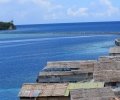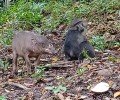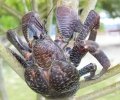Project Update: December 2018
Forest
With some help from a number of tourists, I have cleared more trails around Bird valley; the ridge trail is now connected to the creek trail. If we follow this loop trail, we will see three big and beautiful strangler fig trees—the keystone species of the forest.
In November 2018, I was lucky to find a new valley. It is located just below Pretty—Meidy and I name all but two fig trees with words meaning beautiful in various languages. As the first created down path is too steep for indoor people, I have cleared an easier one.
The new valley is the most valuable among 17 valleys I have found because its floor is full of mud pools with babirusa’s hoofprints; so its name is Babirusa valley. For three years, in hundreds of times wandering in the forest, I had never seen any babirusa. In the last one month, however, I always met them anytime I went into the forest. With this discovery, the night trekking will be exciting because certainly we can see babirusas wallowing in the mud pools and tarsiers jumping between trees; and the grant proposal focusing on saving babirusa I have drafted will have a better chance—I can show babirusa and tarsier, both of them are nocturnal and very elusive, to the visiting prospective funder.
Another important discovery is Jolie, a big fig tree only 700 meters from our bay. Jolie seems one of the sleeping trees of the Hanoman troop of macaques. As it is located not far from coconut groves and our neighbor’s garden, Bonita must be the headquarters of the troop—they raid the groves and garden whenever fruits in the forest are scarce.
The most recent ficus is Bonita. It is located on the ridge of Frog pond, across Wow—the largest, 10 meters wide at the base, fig tree so far on the island and almost all tourists say ‘wow!’ in the first sight of it. The pond would be very beautiful if I have time and energy to clear the undergrowth—mostly thorn plants—so that we can see the diverse big and beautiful trees on the surrounding hill.
Garden
I have abandoned the hill garden because of the lack of water, thin topsoil, and chicken raid. The only plants survive are mango, papaya and lemon grass. We now do gardening only in the yard free of coconut trees. As Siddhartha’s, our little canoe, holes were not repairable, we filled it with soil and bat manure, sowed spinach and lettuce seeds and put a net around the canoe. The harvest is enough for our daily need. I have added another garden by fencing a little area next to our house with coconut trunks. I hope the sown seeds will give us more vegetables.
DoLittle Center
I received some funding from Primate Conservation Inc. for our program of conservation education. For months I looked for a carpenter to construct a building for the program, but none was interested in the offer, albeit the value is above normal locally but below the offer from the resorts around. In the end I decided to construct it by myself.
I paid a local to help me digging, sawing, and hammering nails. The building was completed within a month. It consists of three rooms: storage, library, and learning room. Meidy has moved her collection from our house to the new library and we have furnished the learning rooms with self-made desks and benches from the woods landed on our beach and unused coconut trunks. We name the building Dr. DoLittle Center.
With the remaining fund, I have bought a simple laptop, mini speaker, and slide projector. With these tools, the English course for the local children and guides would be more interesting to them and they will learn faster.





